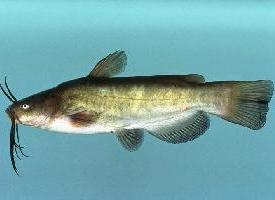
Állatleírás
The Brown Bullhead, scientifically known as Ameiurus nebulosus, is a species of freshwater fish that is a member of the catfish family Ictaluridae. This intriguing creature is native to North America and is widely distributed, inhabiting a range of freshwater environments including rivers, lakes, ponds, and streams. Known for its adaptability, the Brown Bullhead thrives in a variety of water conditions, from clear to turbid and stagnant to slow-moving waters.Physically, the Brown Bullhead is a robust fish with a distinctive, mottled brown appearance that serves as excellent camouflage against the muddy or sandy bottoms of its natural habitats. Its body is stout and laterally compressed, featuring a broad, flat head and a wide mouth equipped with sensitive barbels. These barbels, which resemble whiskers, play a crucial role in the fish's ability to locate food, as they are highly sensitive to touch and taste. This sensory adaptation allows the Brown Bullhead to forage effectively in the murky waters it often inhabits.
Adult Brown Bullheads typically measure between 6 to 10 inches in length, although some individuals can reach up to 20 inches. Their skin is scaleless, and their body is covered in a thick, slimy mucus that helps protect against parasites and infections. The dorsal and pectoral fins of the Brown Bullhead are equipped with sharp, serrated spines that serve as a defense mechanism against predators.
One of the most fascinating aspects of the Brown Bullhead is its reproductive behavior. Spawning occurs in the late spring or early summer when water temperatures reach around 70°F. The fish are nest builders; both male and female work together to create a depression in the substrate, often under logs or rocks, where the female will lay hundreds to thousands of eggs. The parents exhibit a high degree of parental care, guarding the nest aggressively and fanning the eggs with their fins to ensure a steady supply of oxygen.
The diet of the Brown Bullhead is omnivorous and highly varied, including insects, small fish, crustaceans, and plant material. This varied diet, combined with its adaptability to different environmental conditions, has contributed to the species' success and wide distribution.
Despite its resilience, the Brown Bullhead can be affected by environmental degradation, including pollution and habitat destruction. However, it is not currently considered to be at risk of extinction and is classified as a species of least concern by conservation organizations.
In addition to its ecological role, the Brown Bullhead holds cultural significance for many people. It is a popular target for recreational fishermen, appreciated for its fighting spirit and, by some, for its culinary value. However, caution is advised when consuming Brown Bullhead from polluted waters due to the potential for bioaccumulation of toxins.
In summary, the Brown Bullhead (Ameiurus nebulosus) is a fascinating and adaptable freshwater fish, notable for its distinctive appearance, sensory adaptations, and complex reproductive behaviors. Its ability to thrive in a wide range of environmental conditions underscores the remarkable resilience of this species, making it an enduring presence in North American freshwater ecosystems.
Új állatfotók
Top 10 állat
- Diana monkey (Cercopithecus diana)
- Dolphin gull (Leucophaeus scoresbii)
- Moustached guenon (Cercopithecus cephus)
- Galápagos tortoise (Geochelone nigra complex)
- Stone loach (Barbatula barbatula)
- Japanese spider crab (Macrocheira kaempferi)
- Common house mosquito (Culex pipiens)
- Colossal squid (Mesonychoteuthis hamiltoni)
- Common reed warbler (Acrocephalus scirpaceus)
- Sea urchins (Echinoidea)